Exercise 10.1
Question 1.
For each of the given solid, the two views are given. Match for each solid the corresponding top and front views. The first one is done for you.

Solution:
(a) A bottle → (iii) → (iv)
(b) A weight → (i) → (v)
(c) A flask → (iv) → (ii)
(d) Cup and saucer → (v) → (iii)
(e) Container → (ii) → (i)
Question 2.
For each of the given solid, the three views are given. Identify for each solid the corresponding top, front and side views.


Solution:
(a) An Almirah → (i) Front → (ii) Side → (iii) Top
(b) A Match box → (i) Side → (it) Front → (iii) Top
(c) A Television → (i) Front → (ii) Side → (iii) Top
(d) A Car → (i) Front → (ii) Side → (iii) Top
Question 3.
For each given solid, identify the top view, front view and side view.


Solution:
(a) (i) Top → (ii) Front → (iii) Side
(b) (i) Side → (ii) Front → (iii) Top
(c) (i) Top → (ii) Side → (iii) Front
(d) (i) Side → (ii) Front → (iii) Top
(e) (i) Front → (ii) Top → (iii) Side
Question 4.
Draw the front view, side view and top view of the given objects.
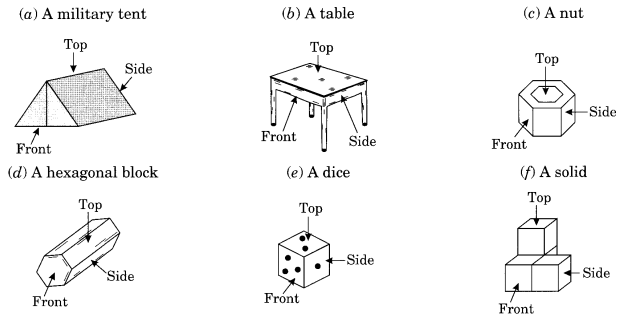
Solution:
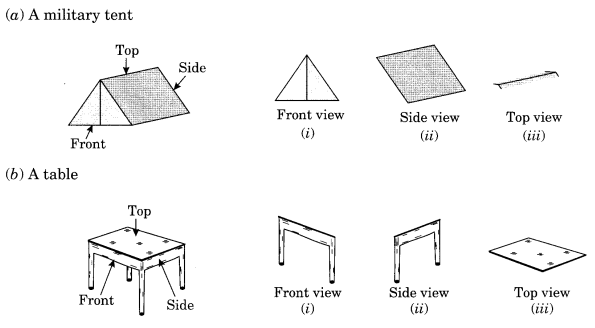

Exercise 10.2
Question 1.
Look at the given map of a city.
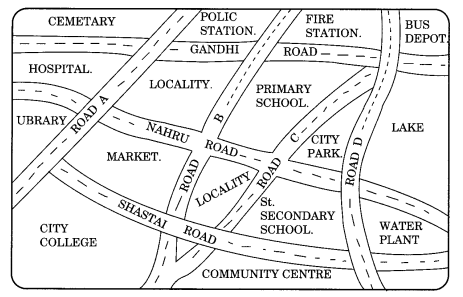
Answer the following.
(a) Colour the map as follows: Blue-water, red- fire station, orange-library, yellow-schools, Green-park, Pink-College, Purple-Hospital, Brown-Cemetery.
(b) Mark a green ‘X’ at the intersection of Road ‘C’ and Nehru Road, Green ‘Y’ at the intersection of Gandhi Road and Road A.
(c) In red, draw a short street route from Library to the bus depot.
(d) Which is further east, the city park or the market?
(e) Which is further south, the primary school or the Sr. Secondary School?
Exercise 10.3
Question 1.
Can a polyhedron have for its faces
(i) 3 triangles?
(ii) 4 triangles?
(iii) a square and four triangles?
Solution:
(i) No, because polyhedron must have edges meeting at vertices which are points.
(ii) Yes, because all the edges are meeting at the vertices.
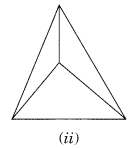
(iii) Yes, because all the eight edges meet at the vertices.
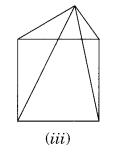
Question 2.
Is it possible to have a polyhedron with any given number of faces?
(Hint: Think of a pyramid)
Solution:

Pyramid
Yes, it is possible if the number of faces is greater than or equal to 4.
Example: Pyramid which has 4 faces.
Question 3.
Which are prisms among the following?
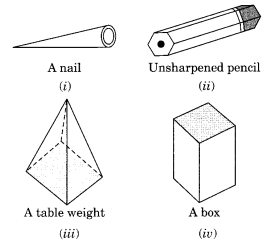
Solution:
Only (ii) unsharpened pencil and (iv) a box are the prism.
Question 4.
(i) How are prisms and cylinders alike?
(ii) How are pyramids and cones alike?
Solution:
(i) If the number of sides in a prism is increased to certain extent, then the prism will take the shape of cylinder.
(ii) If the number of sides of the pyramid is increased to same extent, then the pyramid becomes a cone.
Question 5.
Is a square prism same as a cube? Explain.
Solution:
Every square prism cannot be cube. It may be cuboid also.
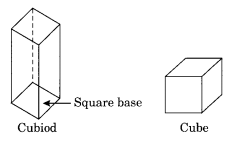
Question 6.
Verify Euler’s formula for these solids.
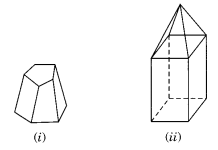
Solution:
(i) Faces = 7
Sides = 15
Vertices = 10
Euler’s formula: F + V – E = 2
⇒ 7 + 10 – 15 = 2
⇒ 2 = 2
Hence, Euler’s formula is verified.
(ii) Faces = 9
Sides = 16
Vertices = 9
Euler’s Formula: F + V – E = 2
⇒ 9 + 9 – 16 = 2
⇒ 2 = 2
Hence, Euler’s formula is verified.
Question 7.
Using Euler’s formula find the unknown.
| Faces | ? | 5 | 20 |
| Vertices | 6 | ? | 12 |
| Edges | 12 | 9 | ? |
Solution:
| Faces | 8 | 5 | 20 |
| Vertices | 6 | 6 | 12 |
| Edges | 12 | 9 | 30 |
Using Eulers Formula: F + V – E = 2
Question 8.
Can a polyhedron have 10 faces, 20 edges and 15 vertices?
Solution:
Here faces = 10, Edges = 20, Vertices = 15
According to Euler’s Formula:
F + V – E = 2
⇒ 10 + 15 – 20 = 25 – 20
⇒ 5 ≠ 2
A polyhedron do not have 10 Faces, 20 Edges and 15 Vertices.


